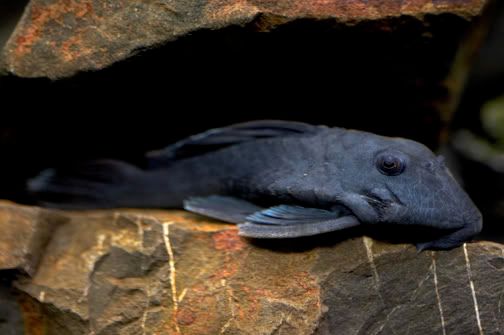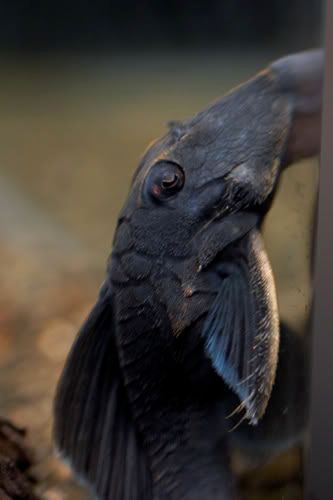Ancistrini sp. (L239)
- NHL
- Posts: 3
- Joined: 14 Mar 2008, 09:24
- My cats species list: 20 (i:0, k:0)
- My aquaria list: 10 (i:0)
- Location 2: Båstad, Norway
-
firenzenz
- Posts: 48
- Joined: 14 Feb 2007, 09:58
- My cats species list: 15 (i:0, k:0)
- Spotted: 1
- Location 1: NZ
Re: Ancistrini sp. (L239)
Hi Nhl
Apologies for riding on your post but i was going to post virtually the same qusetion. I recently acquired two of these plecs, ( I went for what seemed to be pair) and have no info on their breeding.
I have them in the same conditions as the L128's-bouldery rocks and wood with a slate cave as they seem to be from
that area. looking at the other ancistrini sp. there is a wide array of body shapes, hopefully someone here has more info.


Apologies for riding on your post but i was going to post virtually the same qusetion. I recently acquired two of these plecs, ( I went for what seemed to be pair) and have no info on their breeding.
I have them in the same conditions as the L128's-bouldery rocks and wood with a slate cave as they seem to be from
that area. looking at the other ancistrini sp. there is a wide array of body shapes, hopefully someone here has more info.


- racoll
- Posts: 5258
- Joined: 26 Jan 2004, 12:18
- My articles: 6
- My images: 182
- My catfish: 2
- My cats species list: 2 (i:2, k:0)
- My aquaria list: 1 (i:0)
- Spotted: 238
- Location 1: London
- Location 2: UK
Re: Ancistrini sp. (L239)
Nice pictures firenzenz.
With sp like this one that haven't been bred frequently, it is best to try them on standard ancistrine breeding techniques (below).
As far as breeding goes, there really doesn't appear to be much difference between the majority of ancistrine plecos, with the perhaps exception of the blackwater spp.
1. Get a good size group with hopefully males and females!
2. Keep them in warm (~28C), clean, well oxygenated water
3. Feed them well with appropriate foods (L239 are omnivore grazers, so I would feed veggies, algae wafers and the usual frozen foods)
4. Wait for them to get gravid and hairy (remove excess males if required)
5. Provide snug caves (read the Shanes world articles for dimensions and positioning)
6. Drop the temp a few degrees
7. Carry out frequent small water changes with cool, demineralised/RO water
8. Be patient
9. Continue being patient
10. Repeat the above if required

With sp like this one that haven't been bred frequently, it is best to try them on standard ancistrine breeding techniques (below).
As far as breeding goes, there really doesn't appear to be much difference between the majority of ancistrine plecos, with the perhaps exception of the blackwater spp.
1. Get a good size group with hopefully males and females!
2. Keep them in warm (~28C), clean, well oxygenated water
3. Feed them well with appropriate foods (L239 are omnivore grazers, so I would feed veggies, algae wafers and the usual frozen foods)
4. Wait for them to get gravid and hairy (remove excess males if required)
5. Provide snug caves (read the Shanes world articles for dimensions and positioning)
6. Drop the temp a few degrees
7. Carry out frequent small water changes with cool, demineralised/RO water
8. Be patient
9. Continue being patient
10. Repeat the above if required
- racoll
- Posts: 5258
- Joined: 26 Jan 2004, 12:18
- My articles: 6
- My images: 182
- My catfish: 2
- My cats species list: 2 (i:2, k:0)
- My aquaria list: 1 (i:0)
- Spotted: 238
- Location 1: London
- Location 2: UK
Re: Ancistrini sp. (L239)
This is because Ancistrini is not a genus, it is a tribe (a step up from genus). You can tell it is a tribe as it ends in "ini" and is not italicised. If a name ends in "idae" it is a family, and if it ends in "inae" it is a subfamily.looking at the other ancistrini sp. there is a wide array of body shapes, hopefully someone here has more info.
Most of our favourite genera belong in the tribe Ancistrini, such as...
Ancistrus, Hemiancistrus, Baryancistrus, Leporancanthicus, Panaque, Peckoltia, Hypancistrus, Chaetostoma, Acanthicus, Pseudacanthicus and Dekeyseria to name a few.
This is why they are called ancistrine plecos.
If a particular new pleco/L number cannot be placed confidently in a genus by hobbyists, it is placed at the next most inclusive level (in this case tribe). This makes it a kind of trashcan for species that don't fit in other genera. They may require new genera, or more thorough examination and dissection by a professional to be placed in a current genus.
Does that make sense
- NHL
- Posts: 3
- Joined: 14 Mar 2008, 09:24
- My cats species list: 20 (i:0, k:0)
- My aquaria list: 10 (i:0)
- Location 2: Båstad, Norway
Re: Ancistrini sp. (L239)
Thanks!
- Janne
- Expert
- Posts: 1765
- Joined: 01 Jan 2003, 02:16
- My articles: 10
- My images: 243
- Spotted: 73
- Location 2: Belém, Brazil
- Contact:
Re: Ancistrini sp. (L239)
They are blackwater species and will not show so much interest for breeding in normal tapwater parameters, soft and acid water makes them very interested and then follow all other recomended parameters to breed plecos. A pH around 5,5-6,2 and a conductivity around 100-120µS, feed them a varied diet together with frozen Cyclops is very good to condition them. The male will grow very long odontodes on his cheek and the female will become very plump when they are ready to breed, they prefer quite warm water 29-30C and many plecos is triggered to spawn when increasing the temp instead of to lower the temp.
Janne
Janne
- racoll
- Posts: 5258
- Joined: 26 Jan 2004, 12:18
- My articles: 6
- My images: 182
- My catfish: 2
- My cats species list: 2 (i:2, k:0)
- My aquaria list: 1 (i:0)
- Spotted: 238
- Location 1: London
- Location 2: UK
Re: Ancistrini sp. (L239)
The accepted wisdom states that cool water changes stimulate a spawn after a conditioning period in warm water. Which loricariid species require the opposite Janne?many pl*cos is triggered to spawn when increasing the temp instead of to lower the temp.
- Janne
- Expert
- Posts: 1765
- Joined: 01 Jan 2003, 02:16
- My articles: 10
- My images: 243
- Spotted: 73
- Location 2: Belém, Brazil
- Contact:
Re: Ancistrini sp. (L239)
Yes I know, but it's also recomended to raise the temperature back to normal after some cool water changes and then they breed. Many species not only loricariids are stimulated of a raised temperature after being kept in a slightly lower temp that usual, you could giving it a try keeping a breeding pair or group in a temperature of 27 C for a period and then raise the temperature to 29-30 C using the normal water changes routines. The opposite that recomended, keep the fishes in a little lower temp and then raise the temp instead to lower the temp for a short time and then raise the temp back to normal. You will see how much more active they will be and start to show interest for breeding. Almost all rivers, ponds and backwaters in the lower amazon area is very warm all year around even under the rainy season, very seldom under 28 C but mostly around 29-32 C. Other areas with little higher altitude or more south of the amazon area is more variable when it comes to the water temperature.racoll wrote:The accepted wisdom states that cool water changes stimulate a spawn after a conditioning period in warm water. Which loricariid species require the opposite Janne?
Janne
- racoll
- Posts: 5258
- Joined: 26 Jan 2004, 12:18
- My articles: 6
- My images: 182
- My catfish: 2
- My cats species list: 2 (i:2, k:0)
- My aquaria list: 1 (i:0)
- Spotted: 238
- Location 1: London
- Location 2: UK
Re: Ancistrini sp. (L239)
Indeed. I may have been a bit brief in my summary of the methods. Thanks for clearing that up Janne.t's also recomended to raise the temperature back to normal after some cool water changes and then they breed
NHL, firenzenx, try a forum search for more information on breeding techniques for other ancistrine plecos, as much will apply to L239.
- NHL
- Posts: 3
- Joined: 14 Mar 2008, 09:24
- My cats species list: 20 (i:0, k:0)
- My aquaria list: 10 (i:0)
- Location 2: Båstad, Norway
Re: Ancistrini sp. (L239)
Thak you for exelent ifo.
- Yann
- Posts: 3617
- Joined: 30 Dec 2002, 20:56
- I've donated: $20.00!
- My articles: 8
- My images: 276
- My cats species list: 81 (i:0, k:0)
- My BLogs: 2 (i:3, p:90)
- Spotted: 109
- Location 1: Switzerland
- Location 2: Switzerland
- Interests: Catfish mainly form South America, Cichlids, Geckos, Horses WWII airplanes, Orchids
Re: Ancistrini sp. (L239)
Hi!
2 spawn have happened in France, with unfortunately fry dying a few days after eclosion!!
Hopefully the next ones will be succesfull!
I have to check the water parameter of the tank.
I know the tank is rather big with a big group in in... the water flow is also very important!!
Cheers
Yann
2 spawn have happened in France, with unfortunately fry dying a few days after eclosion!!
Hopefully the next ones will be succesfull!
I have to check the water parameter of the tank.
I know the tank is rather big with a big group in in... the water flow is also very important!!
Cheers
Yann
Don't Give Up, Don't Ever Give Up!




